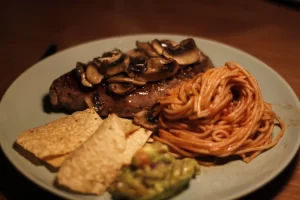There’s a unique joy in twirling a fork through a plate of freshly made spaghetti, especially when you’ve made the pasta yourself. The art of making homemade spaghetti is both simple and gratifying, transforming a few basic ingredients into something extraordinary. Whether you’re a seasoned cook or a novice in the kitchen, the process of crafting your own spaghetti offers a delightful adventure in culinary creation.
Thank you for reading this post, don't forget to subscribe!In this guide, we’ll explore five easy recipes for making homemade spaghetti that cater to a variety of tastes and dietary needs. From the classic egg and flour combination to innovative spins with herbs, spinach, or beetroot, and even a gluten-free option, there’s something here for everyone. Each recipe is designed to be straightforward and accessible, ensuring that anyone can bring the taste of authentic, handcrafted pasta into their home. Let’s dive into the world of pasta making, where each strand weaves a story of tradition and creativity.
5 Easy Reciepes for Homemade Spaghetti
“Spaghetti, one of the world’s most beloved pasta forms, has woven its way through various cultures, each adding a unique twist to this simple yet versatile dish. Originating from Italy, spaghetti is traditionally served with rich tomato sauces, fresh herbs, and various forms of proteins like meatballs or seafood. However, its adaptability has allowed it to be reinvented globally.
In the United States, spaghetti often incorporates bolder ingredients such as chili flakes and ground beef, creating a hearty family meal. In Asia, particularly in Japan, it’s even taken on local flavors with additions like soy sauce and spicy cod roe. Each variation of spaghetti not only highlights local tastes but also showcases the universal appeal of this iconic noodle, making it a staple in households around the world.”
1. Basic Homemade Spaghetti
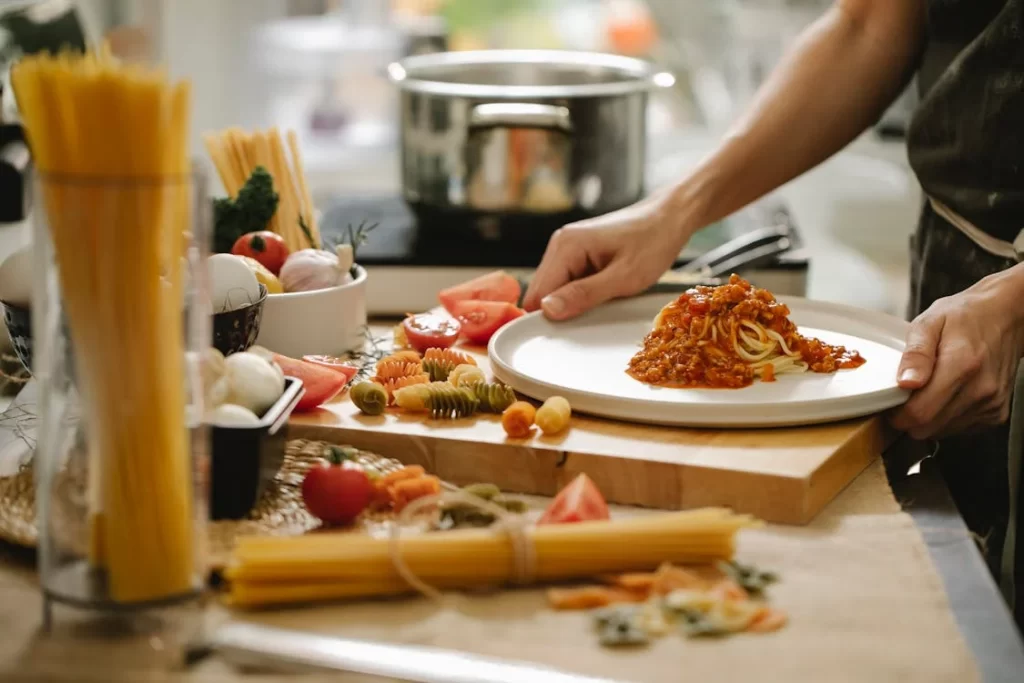
Ingredients Needed:
- All-purpose flour: 2 cups
- Eggs: 3 large
- Salt: 1/2 teaspoon
Equipment Required:
- Rolling pin or pasta machine
- Large mixing bowl
- Fork or dough whisk
- Knife or pasta cutter
- Large pot for boiling water
- Colander
Step-by-Step Instructions:
A. Mixing the Dough:
- Place the Flour: Pour the flour into a large mixing bowl. Make a well in the center of the flour pile.
- Add Eggs and Salt: Break the eggs into the well. Add the salt over the eggs.
- Begin Mixing: Using a fork or dough whisk, gently beat the eggs and begin to incorporate the surrounding flour. Gradually draw more flour into the eggs until all the flour is moistened.
B. Kneading and Resting the Dough:
- Knead the Dough: Once the dough begins to come together in the bowl, transfer it to a clean, lightly floured surface. Knead the dough by hand for about 10 minutes, until it is smooth and elastic.
- Rest the Dough: Form the dough into a ball and cover it with a clean, damp cloth. Let it rest for 30 minutes at room temperature. This allows the gluten in the flour to relax, making the dough easier to roll out.
C. Rolling Out the Dough and Cutting It into Spaghetti Strands:
- Roll the Dough: After resting, divide the dough into quarters. Work with one piece at a time, keeping the rest covered. Flatten the dough with your hands and then use a rolling pin or pasta machine to roll it out into a thin sheet, about 1-2mm thick.
- Cut the Spaghetti: If using a knife, lightly flour the rolled-out dough and roll it up loosely. Use a sharp knife to cut thin strips (about 1/4 inch wide). If using a pasta machine, run the thin dough sheet through the spaghetti cutter attachment.
- Unravel and Dust: Gently unravel the cut spaghetti strands and dust them with a little flour to prevent sticking.
Cooking Tips:
- Boiling the Spaghetti: Bring a large pot of salted water to a rolling boil. Add the spaghetti and cook for 2-3 minutes, or until al dente. Fresh pasta cooks much quicker than dried pasta.
- Testing for Doneness: Taste a strand after 2 minutes; it should be tender but still firm to the bite.
- Drain: Use a colander to drain the spaghetti, but do not rinse. This helps the sauce adhere to the pasta.
This recipe for basic homemade spaghetti offers a wonderful introduction to pasta making and can be a delightful way to create a delicious, fresh meal from simple ingredients. Enjoy your homemade spaghetti with your favorite sauce and fresh herbs for a satisfying dish.
2. Spinach Spaghetti
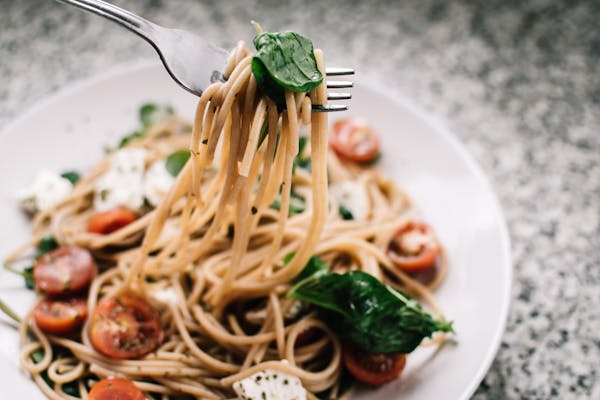
Ingredients Needed:
- Spinach: 1 cup fresh or 1/2 cup frozen, thawed
- All-purpose flour: 2 cups
- Eggs: 2 large
- Salt: 1/2 teaspoon (optional)
Health Benefits:
Spinach is a powerhouse of nutrients, loaded with vitamins A, C, K, iron, fiber, and antioxidants. Incorporating spinach into your spaghetti not only boosts the nutritional content but also adds a vibrant green color to the dish. It’s a great way to increase your vegetable intake while enjoying a classic comfort food.
Preparation Method:
1. Prepare the Spinach:
- If using fresh spinach, wash it thoroughly to remove any dirt or grit.
- Blanch the spinach in boiling water for 1-2 minutes until wilted. If using frozen spinach, ensure it’s completely thawed and drained.
- Squeeze out as much water as possible from the spinach to avoid a soggy dough.
- Chop the spinach finely or puree it in a food processor for a smoother texture.
2. Make the Dough:
- In a large bowl, mix the flour and salt.
- Make a well in the center and add the eggs and spinach puree.
- Gradually mix the flour into the eggs and spinach, combining with a fork until the mixture begins to form a dough.
- Transfer the dough onto a floured surface and knead it for 8-10 minutes until it’s smooth and elastic. If the dough is too sticky, add a little more flour; if it’s too dry, add a few drops of water.
3. Rest the Dough:
- Wrap the dough in plastic wrap and let it rest at room temperature for at least 30 minutes. This helps the gluten in the flour relax and makes the dough easier to roll out.
4. Roll and Cut the Dough:
- Divide the dough into four equal parts.
- Using a rolling pin or a pasta machine, roll out each piece of dough to your desired thickness, typically about 1-2 mm for spaghetti.
- Cut the rolled dough into thin strands using a knife or a pasta cutter.
5. Cook the Spaghetti:
- Bring a large pot of salted water to a boil.
- Cook the spaghetti for 2-4 minutes, or until they float to the top and are al dente.
- Drain and rinse quickly under warm water to prevent sticking.
Serving Suggestions:
Spinach spaghetti pairs wonderfully with a variety of sauces and toppings. Here are a few ideas:
- Garlic and Olive Oil: Saute garlic in olive oil and toss the cooked spaghetti for a light and flavorful dish.
- Creamy Alfredo: Serve with a rich Alfredo sauce to complement the earthy tones of the spinach.
- Tomato Basil: Top with a fresh tomato basil sauce for a classic Italian flavor.
- Lemon and Parmesan: Drizzle with lemon juice and sprinkle with Parmesan cheese for a refreshing twist.
Spinach spaghetti offers a nutritious and visually appealing alternative to traditional pasta dishes, perfect for adding a touch of gourmet to your homemade meals.
3. Gluten-Free Spaghetti
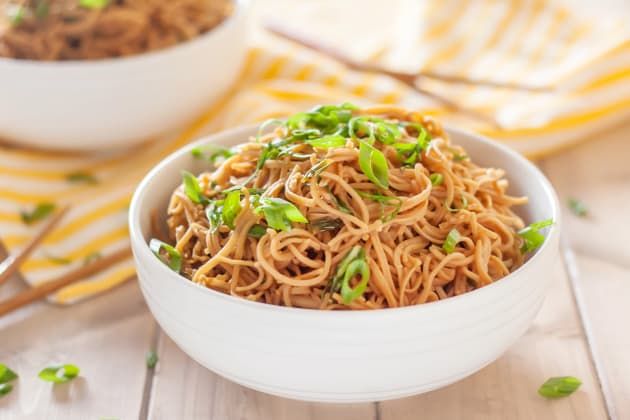
Ingredients Needed:
- Gluten-free flour mix (such as a blend of rice, tapioca, and potato starch)
- Xanthan gum
- Eggs
- Salt (optional)
Challenges and Solutions:
- Challenge: Gluten-free dough can be crumbly and hard to work with.
- Solution: Ensure that your flour mix is finely ground to improve texture. Adding xanthan gum helps bind the ingredients, mimicking the elasticity provided by gluten.
- Challenge: The dough may dry out faster.
- Solution: Keep the dough covered with a damp cloth while working with portions to prevent it from drying out.
Step-by-Step Instructions:
1. Mix the Ingredients:
- In a large bowl, combine 2 cups of gluten-free flour mix, 1 teaspoon of xanthan gum, and a pinch of salt.
- Make a well in the center and add 3 beaten eggs.
- Gradually mix the dry ingredients into the eggs until a dough forms.
2. Knead the Dough:
- Transfer the dough to a surface dusted with gluten-free flour.
- Knead gently for a few minutes until the dough is smooth. If the dough is too sticky, add a bit more flour.
3. Rest the Dough:
- Wrap the dough in plastic wrap and let it rest at room temperature for at least 30 minutes. This allows the xanthan gum to hydrate and the dough to become more manageable.
4. Roll Out the Dough:
- Divide the dough into smaller portions for easier rolling.
- Roll each portion into a thin sheet using a rolling pin or a pasta machine. Dust with gluten-free flour as needed to prevent sticking.
5. Cut into Strands:
- Use a sharp knife or a pasta cutter to cut the rolled-out dough into thin spaghetti strands.
- Dust the strands lightly with flour to prevent sticking and lay them out flat on a baking sheet or hang them on a pasta drying rack.
Cooking and Serving Tips:
- Cooking Gluten-Free Spaghetti:
- Bring a large pot of salted water to a boil. Add the spaghetti, stirring gently at the beginning to prevent the strands from sticking together.
- Cook for 2-4 minutes, or until the pasta is al dente. Gluten-free pasta can overcook quickly, so it’s important to taste test during cooking.
- Drain the pasta in a colander and rinse briefly under warm water to remove excess starch, which helps prevent sticking.
- Serving Suggestions:
- Serve immediately with your choice of sauce. Gluten-free spaghetti pairs well with light sauces that don’t overpower the delicate texture of the pasta.
- Add a drizzle of olive oil and toss gently before adding the sauce to help prevent the strands from sticking together.
This gluten-free spaghetti recipe offers a satisfying alternative to traditional pasta, perfect for those managing gluten sensitivities or celiac disease. The key is gentle handling and not overcooking the pasta to maintain the best texture and flavor.
4. Herb-Infused Spaghetti
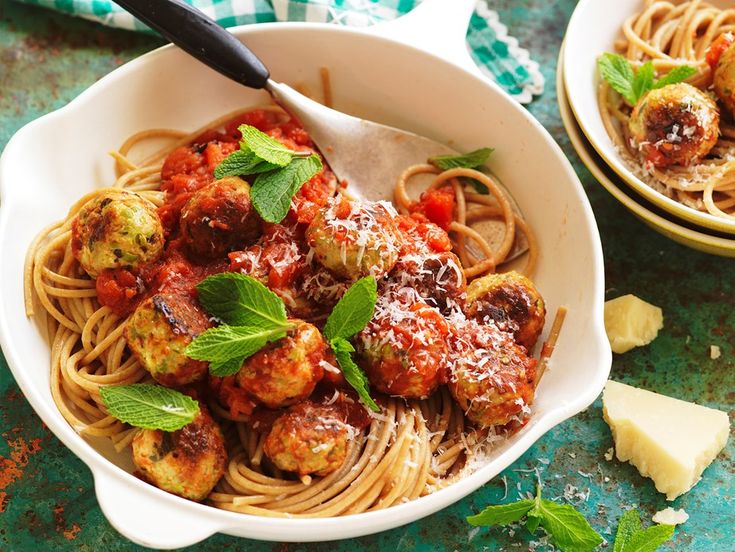
Ingredients Needed:
- Fresh herbs (such as basil and parsley)
- Flour (all-purpose or 00 flour recommended)
- Eggs
Preparation Method:
1. Prepare the Herbs:
- Start by thoroughly washing your fresh herbs—basil and parsley work well for this recipe. Pat them dry to remove any excess moisture.
- Finely chop the herbs. You’ll need about 1/4 cup of chopped herbs for each 2 cups of flour used.
2. Blend the Herbs with Eggs:
- Crack the eggs into a blender. For every 2 cups of flour, use 3 large eggs.
- Add the chopped herbs to the eggs in the blender.
- Blend the mixture until the herbs are finely dispersed throughout the eggs, giving you a green-tinted liquid.
3. Mix and Knead the Dough:
- Place your flour in a large mixing bowl and create a well in the center.
- Pour the herb-egg mixture into the well.
- Using a fork, gradually incorporate the flour into the eggs from the edges of the well. Continue until the mixture becomes a sticky dough.
- Turn the dough onto a floured surface and knead for about 10 minutes, or until it becomes smooth and elastic. If the dough is too sticky, add a little more flour as you knead.
4. Rest the Dough:
- Wrap the kneaded dough in plastic wrap and let it rest at room temperature for at least 30 minutes. This resting period helps the gluten in the dough relax, making it easier to roll out.
5. Roll and Cut the Spaghetti:
- After resting, divide the dough into four equal portions for easier handling.
- Using a pasta machine or a rolling pin, roll out one portion of the dough at a time to your desired thickness.
- Then, using a pasta cutter or a sharp knife, cut the rolled-out dough into thin spaghetti strands.
- Dust the cut spaghetti with a bit of flour to prevent sticking.
6. Cook the Pasta:
- Bring a large pot of salted water to a boil.
- Cook the spaghetti for 2-3 minutes, or until it floats to the surface and is al dente.
- Drain and serve immediately.
7. Flavor Pairings:
- Sauces: Herb-infused spaghetti pairs beautifully with light and fresh sauces. Consider a simple garlic and olive oil sauce, a light cream sauce, or a lemon-butter sauce to enhance the fresh herbal flavors without overpowering them.
- Dishes: Serve alongside grilled vegetables or a fresh salad for a complete meal. This pasta also works well with seafood dishes, such as shrimp or scallops, that complement the herbaceous flavors of the pasta.
This herb-infused spaghetti brings a delightful twist to traditional pasta dishes, adding a fresh burst of flavor that’s perfect for a variety of meals. Experiment with different herbs and sauces to find your favorite combinations!
5. Red Beet Spaghetti
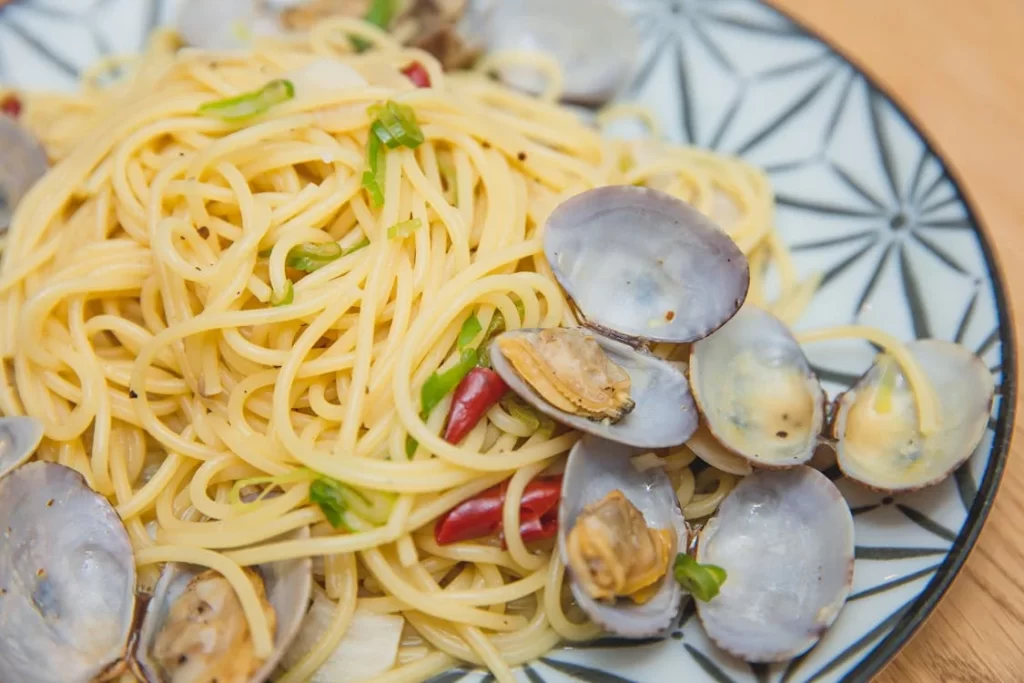
Ingredients Needed:
- 1 cup beetroot juice (freshly juiced for best results)
- 2 cups all-purpose flour (or a gluten-free alternative if preferred)
- 2 large eggs
- A pinch of salt (optional)
Visual Appeal and Health Benefits:
Red Beet Spaghetti is not just visually striking with its vivid red color, but it’s also a healthy alternative to your regular pasta. Beetroot is rich in iron, potassium, and vitamin C, making this spaghetti not only a treat for the eyes but also beneficial for boosting stamina and immune system health. The natural sweetness of the beet also adds a unique flavor profile to the pasta.
Preparation Steps:
1. Mix Ingredients:
- In a large mixing bowl, pour in the flour and create a well in the center.
- Add the eggs and beetroot juice into the well and sprinkle with a pinch of salt.
- Gradually incorporate the flour into the liquid ingredients, mixing until the dough begins to form.
2. Knead the Dough:
- Transfer the dough onto a lightly floured surface.
- Knead the dough for about 10 minutes, or until it is smooth and elastic. Add a little more flour if the dough is too sticky.
3. Rest the Dough:
- Wrap the kneaded dough in plastic wrap and let it rest at room temperature for about 30 minutes. This helps the gluten relax and makes the dough easier to roll out.
4. Roll and Cut the Dough:
- After resting, divide the dough into manageable pieces.
- Using a rolling pin or a pasta machine, roll each piece into thin sheets.
- Cut the sheets into thin spaghetti strands using a sharp knife or a pasta cutter.
5. Cook the Spaghetti:
- Bring a large pot of salted water to a boil.
- Cook the spaghetti for 2-4 minutes, or until al dente.
- Drain and rinse briefly under warm water to prevent sticking.
Suggested Pairings:
Red Beet Spaghetti pairs wonderfully with flavors that complement its earthiness and natural sweetness. Consider the following sauces and toppings:
- Goat Cheese and Walnut Sauce: The creaminess of goat cheese and the crunch of walnuts create a rich texture and flavor contrast.
- Garlic and Olive Oil: A simple aglio e olio sauce with plenty of garlic, olive oil, and a sprinkle of chili flakes accentuates the pasta’s natural flavors without overpowering them.
- Basil Pesto: The fresh, aromatic qualities of basil pesto make it a vibrant topping that matches the visual appeal of the beet spaghetti.
- Gorgonzola and Pear: For a more adventurous pairing, the sharpness of Gorgonzola and the sweet notes of pear provide a sophisticated balance.
This recipe not only serves as a delightful culinary experiment but also adds a burst of color and nutrition to your meal. Whether dressed up for a special occasion or enjoyed as a healthful dinner, Red Beet Spaghetti is sure to impress.
Making homemade spaghetti is not just about cooking—it’s a delightful expression of creativity and personal taste. Each strand you roll and cut carries a bit of your culinary flair and the joy of crafting something from scratch. The recipes provided here serve as a canvas, inviting you to infuse each dish with your unique touch. Whether it’s experimenting with different flours for the basic spaghetti, incorporating vibrant vegetables like spinach and beetroot, or adding a burst of flavor with fresh herbs, the possibilities are endless.
Homemade spaghetti also offers a special satisfaction that can’t be found in store-bought varieties. There’s a significant delight in tasting pasta that’s been made with your own hands, tailored to your preferences in flavor and texture. So, dive into these recipes, adjust the ingredients, and play with the pairings to suit your palate. Embrace the process, enjoy the results, and most importantly, share the delicious outcomes with friends and family. Let the adventure of homemade spaghetti-making begin!
If you want to read the How Ramen Noodles are Cooked……
